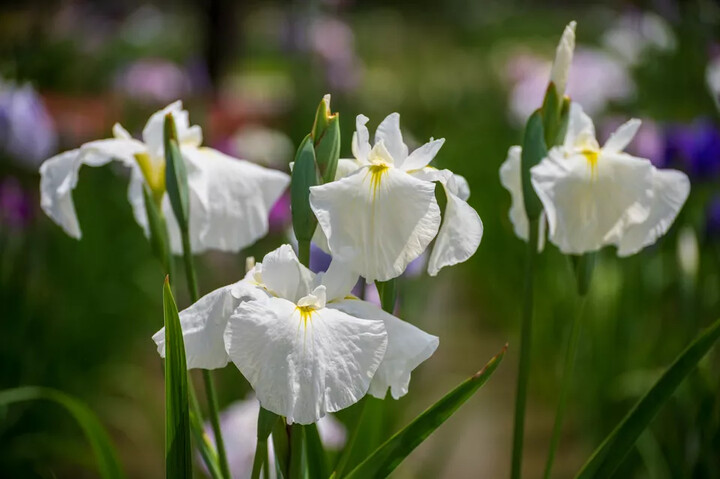A member of the Iridaceae family, Japanese iris is related both to irises commonly grown in the landscape, such as the bearded irises (Iris germanica), and to such wild iris plants as the Northern blue flag (Iris versicolor), a native of North America. Japanese iris comes in a number of colors. The flowers are flattish and 3 to 6 inches across, making for an impressive display. Because it likes to grow around water during the spring and summer months, it is useful in certain problem areas of the landscape where other plants would fail miserably.
Botanical Name:
Iris ensata
Common Name:
Japanese iris, Japanese water iris, Japanese flag, sword-leafed iris
Plant Type:
Herbaceous perennial
Mature Size:
2 to 4 feet tall and 1.5 to 2 feet wide
Sun Exposure:
Full sun to partial shade
Soil Type:
Friable
Soil pH
:Slightly acidic
Bloom Time:
June and July
Flower Color:
Blue, lavender, pink, or white
Hardiness Zones:
4 to 9
Native Area:
Eastern Asia, Kazakhstan
How to Grow Japanese Iris
Japanese iris is a bit fussy in its growing requirements. You need to give it just the right sun, soil, and spacing conditions. It is not as easy to grow as many other types of iris. At least the job of growing it is made easier by the fact that it is not a favorite food of deer pests. In fact, it is partly because the deer tend to leave it alone that Japanese iris will sometimes naturalize in North America.
Its chief enemies are compacted soil, improper irrigation, and overcrowding:
When soil particles become too tightly packed together, the roots of the Japanese iris cannot breathe, and the plant suffers. This is why it is critically important to provide the plant with soil that is friable.
Japanese iris is a Goldilocks when it comes to water needs. It needs a lot of it in spring, less (but still a significant amount) in summer, and way less in fall and winter.
Japanese iris spreads via underground rhizomes. A colony of the plants will grow vigorously and soon start to grow into each other's space, resulting in overcrowding. To solve the problem, transplant some of the plants out of their patch to another suitable spot in the yard. This will give sufficient "elbow room" to the remaining plants.
Light
This perennial performs best in full sun unless you are growing it in an area that experiences very hot summers. In the latter case, it profits from a bit of afternoon shade.
Soil
Japanese iris wants a friable, loamy soil.
Water
Make sure that Japanese iris is supplied with proper irrigation; the amount required varies based on the time of year. This plant requires more water than do many landscape plants during the growing season. This is especially true in the spring, the season when the plant is growing the most actively. But, even in summer, keep the soil evenly moist; never let it dry out completely during the summer. Problem is, during the rest of the year (fall and winter), it can suffer from being in excess water. So you have to strike a careful balance.
Fertilizer
This plant is a heavy feeder. Grow it in an area that has been amended previously with organic matter and work compost into the soil around it annually.
Uses for Japanese Iris in the Landscape
Because of its tolerance for wet soil in spring and summer, the Japanese iris is an ideal candidate for use around water features, swimming pools, ponds, and streams. But that only begins to tell the tale of how useful a plant tolerant of wet soils can be. Many landscapes suffer from depressions where water collects and the soil remains soggy for extended periods of time in the spring. Most plants do not grow well in such places, leaving homeowners at a loss as to what to plant there. Japanese iris can be a great boon in these cases, covering the ground while furnishing color at the same time.
Because the plant is finicky about water (whether too little or too much), the easiest way to grow Japanese iris is as a potted plant for your water feature. When plants are grown in containers, they give you more flexibility because you can move them around based on the plants' needs and your own needs. You can even place a potted Japanese iris in standing water during the spring and summer. Because the plant is intolerant of excessive water in the off-season, you can simply:
Take the pot out of your water garden in the fall.
Plant the Japanese iris, pot and all, in the ground somewhere else in your garden to overwinter.
And then transport the plant, pot and all, back to the water feature next spring.
You Might Like ...